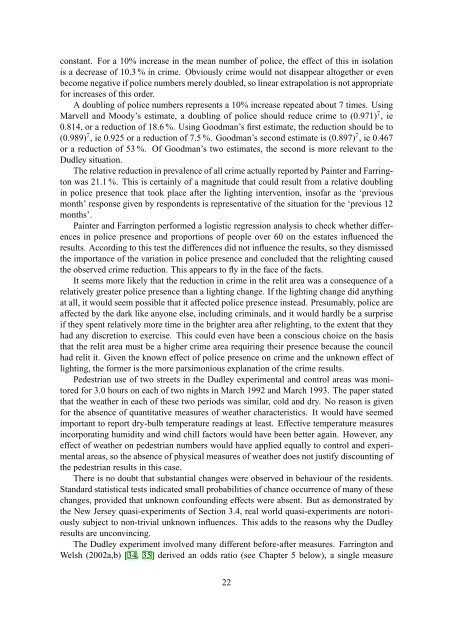outdoor lighting and crime, part 1 - Astronomical Society of Victoria
outdoor lighting and crime, part 1 - Astronomical Society of Victoria
outdoor lighting and crime, part 1 - Astronomical Society of Victoria
Create successful ePaper yourself
Turn your PDF publications into a flip-book with our unique Google optimized e-Paper software.
constant. For a 10% increase in the mean number <strong>of</strong> police, the effect <strong>of</strong> this in isolation<br />
is a decrease <strong>of</strong> 10.3 % in <strong>crime</strong>. Obviously <strong>crime</strong> would not disappear altogether or even<br />
become negative if police numbers merely doubled, so linear extrapolation is not appropriate<br />
for increases <strong>of</strong> this order.<br />
A doubling <strong>of</strong> police numbers represents a 10% increase repeated about 7 times. Using<br />
Marvell <strong>and</strong> Moody’s estimate, a doubling <strong>of</strong> police should reduce <strong>crime</strong> to (0.971) 7 , ie<br />
0.814, or a reduction <strong>of</strong> 18.6 %. Using Goodman’s first estimate, the reduction should be to<br />
(0.989) 7 , ie 0.925 or a reduction <strong>of</strong> 7.5 %. Goodman’s second estimate is (0.897) 7 , ie 0.467<br />
or a reduction <strong>of</strong> 53 %. Of Goodman’s two estimates, the second is more relevant to the<br />
Dudley situation.<br />
The relative reduction in prevalence <strong>of</strong> all <strong>crime</strong> actually reported by Painter <strong>and</strong> Farrington<br />
was 21.1 %. This is certainly <strong>of</strong> a magnitude that could result from a relative doubling<br />
in police presence that took place after the <strong>lighting</strong> intervention, ins<strong>of</strong>ar as the ‘previous<br />
month’ response given by respondents is representative <strong>of</strong> the situation for the ‘previous 12<br />
months’.<br />
Painter <strong>and</strong> Farrington performed a logistic regression analysis to check whether differences<br />
in police presence <strong>and</strong> proportions <strong>of</strong> people over 60 on the estates influenced the<br />
results. According to this test the differences did not influence the results, so they dismissed<br />
the importance <strong>of</strong> the variation in police presence <strong>and</strong> concluded that the re<strong>lighting</strong> caused<br />
the observed <strong>crime</strong> reduction. This appears to fly in the face <strong>of</strong> the facts.<br />
It seems more likely that the reduction in <strong>crime</strong> in the relit area was a consequence <strong>of</strong> a<br />
relatively greater police presence than a <strong>lighting</strong> change. If the <strong>lighting</strong> change did anything<br />
at all, it would seem possible that it affected police presence instead. Presumably, police are<br />
affected by the dark like anyone else, including criminals, <strong>and</strong> it would hardly be a surprise<br />
if they spent relatively more time in the brighter area after re<strong>lighting</strong>, to the extent that they<br />
had any discretion to exercise. This could even have been a conscious choice on the basis<br />
that the relit area must be a higher <strong>crime</strong> area requiring their presence because the council<br />
had relit it. Given the known effect <strong>of</strong> police presence on <strong>crime</strong> <strong>and</strong> the unknown effect <strong>of</strong><br />
<strong>lighting</strong>, the former is the more parsimonious explanation <strong>of</strong> the <strong>crime</strong> results.<br />
Pedestrian use <strong>of</strong> two streets in the Dudley experimental <strong>and</strong> control areas was monitored<br />
for 3.0 hours on each <strong>of</strong> two nights in March 1992 <strong>and</strong> March 1993. The paper stated<br />
that the weather in each <strong>of</strong> these two periods was similar, cold <strong>and</strong> dry. No reason is given<br />
for the absence <strong>of</strong> quantitative measures <strong>of</strong> weather characteristics. It would have seemed<br />
important to report dry-bulb temperature readings at least. Effective temperature measures<br />
incorporating humidity <strong>and</strong> wind chill factors would have been better again. However, any<br />
effect <strong>of</strong> weather on pedestrian numbers would have applied equally to control <strong>and</strong> experimental<br />
areas, so the absence <strong>of</strong> physical measures <strong>of</strong> weather does not justify discounting <strong>of</strong><br />
the pedestrian results in this case.<br />
There is no doubt that substantial changes were observed in behaviour <strong>of</strong> the residents.<br />
St<strong>and</strong>ard statistical tests indicated small probabilities <strong>of</strong> chance occurrence <strong>of</strong> many <strong>of</strong> these<br />
changes, provided that unknown confounding effects were absent. But as demonstrated by<br />
the New Jersey quasi-experiments <strong>of</strong> Section 3.4, real world quasi-experiments are notoriously<br />
subject to non-trivial unknown influences. This adds to the reasons why the Dudley<br />
results are unconvincing.<br />
The Dudley experiment involved many different before-after measures. Farrington <strong>and</strong><br />
Welsh (2002a,b) [34, 35] derived an odds ratio (see Chapter 5 below), a single measure<br />
22
















